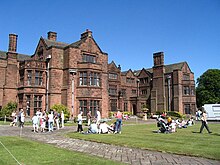Thornton Manor
| Thornton Manor | |
|---|---|

Thornton Manor main front
|
|
| Location | Thornton Hough, Wirral, Merseyside, England |
| Coordinates | 53°19′39″N 3°03′07″W / 53.3276°N 3.0519°WCoordinates: 53°19′39″N 3°03′07″W / 53.3276°N 3.0519°W |
| OS grid reference | SJ 300,817 |
| Built | Mid 19th century |
| Built for | Charles William Potts William Lever |
| Rebuilt | c. 1896, 1913 |
| Architect | Jonathan Simpson Douglas & Fordham J. J. Talbot Grayson and Ould J. Lomax-Simpson |
| Architectural style(s) | Elizabethan style |
|
Listed Building – Grade II*
|
|
| Designated | 2 December 1986 |
| Reference no. | 1075420 |
Thornton Manor is a large house in the village of Thornton Hough, Wirral, Merseyside, England. It is recorded in the National Heritage List for England as a designated Grade II* listed building. The house was first built in the middle of the 19th century and has been altered and extended in a number of phases since. From 1888 to the end of the 20th century the house was occupied by the Viscounts Leverhulme. It is now used as a conference and events centre, and a venue for weddings.
The land on which the house stands was owned originally by the Mostyn family of North Wales. The land was bought in 1849 by Charles William Potts, a solicitor. It is thought that he built the manor house, but there is no evidence that he lived there. In 1863 Potts sold the house and land to Thomas Brittain Forwood, a businessman who died in 1884. His son, Sir William Forwood, chairman of Liverpool Overhead Railway, let the house to William Lever (later 1st Viscount Leverhulme), builder of the soap factory and model village at Port Sunlight, in 1888.
Thornton Manor became the home of the Viscount Leverhulmes. William Lever bought the house in 1893 and lived here from 1888 until 1919, retaining ownership until his death in 1925. Lever started on a series of alterations and additions soon after his purchase. The architect Jonathan Simpson made some minor alterations but the first major work was designed by the Chester firm Douglas and Fordham in about 1896. This constituted the main block of the house and was in Elizabethan style.
In 1899 stables designed by J. J. Talbot were built and around this time a kitchen and service quarters designed by Grayson and Ould were added. In 1902 a music room followed, also designed by Talbot, and this formed a new block to the northeast of the main block. Two years later a temporary ballroom was built, which was later converted into a swimming pool. A porch was added to the south front in 1906, changing the main entrance to the house from the west to the south. A gatehouse designed by J. Lomax-Simpson was built in 1910; the base of this is in stone and its upper part is half-timbered.
...
Wikipedia

